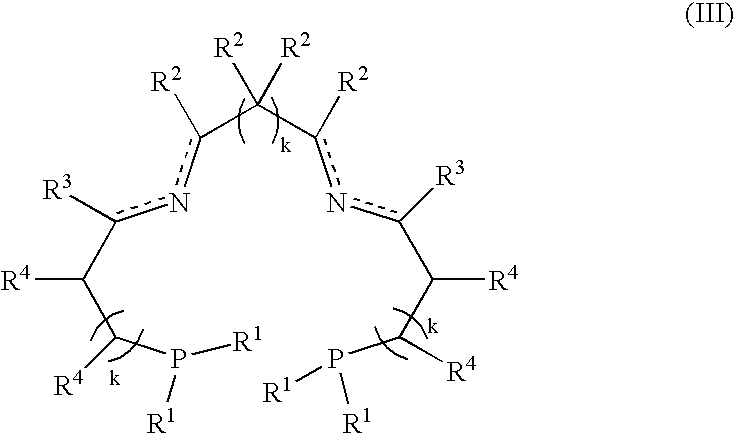Process for hydrogenation of carbonyl and iminocarbonyl compounds using ruthenium catalysts comprising tetradentate diimino-diphosphine ligands
a technology of tetradentate diimino-diphosphine and catalyst, which is applied in the direction of organic compound/hydride/coordination complex catalyst, physical/chemical process catalyst, ruthenium organic compound, etc., can solve the problems of ru/p.sub.2(nh), the use of ru/p.sub.2(nh) complex is more difficult to achieve, and the use of these two types of complexes is inconvenien
- Summary
- Abstract
- Description
- Claims
- Application Information
AI Technical Summary
Problems solved by technology
Method used
Image
Examples
example 1
[0055] General Procedure for the Catalytic Hydrogenation of Ketones and Aldehydes with the Complexes [Ru(P.sub.2N.sub.2Y.sub.2] or [Ru(P.sub.2(NH).sub.2)Y.sub.2]
[0056] A typical experiment was as follows:
[0057] A 0.002 M solution of the complex [RuCl.sub.2((R,R)-cyP.sub.2(NH).s-ub.2)] was prepared by dissolving 9.9 mg (0.01 mmol) of the complex in 5 ml of CH.sub.2Cl.sub.2.
[0058] A 0.18 M solution of .sup.iPrOK was prepared by dissolving 202 mg (1.8 mmol) .sup.tBuOK in 10 ml iPrOH.
[0059] The glass insert of an autoclave was charged with 7.2 ml .sup.iPrOH and 10 .mu.l of the 0.18 M solution of .sup.iPrOK (1.8.times.10.sup.-3 mmol). Then, to this mixture were added 2.4 g of acetophenone(20 mmol) and 10 .mu.l of the 0.002 M complex solution (2.times.10.sup.-5 mmol), resulting thus in a reaction mixture having a complex / base / substrate ratio of 1:90:10.sup.6 (1 ppm of complex).
[0060] The charged insert was placed inside the autoclave, which was sealed and pressurized with 45 bar of H.sub....
example 2
[0068] Comparison Between the Performances of the [Ru(P.sub.2N.sub.2)Y.sub-.2] Complexes and their [Ru(P.sub.2(NH).sub.2)Y.sub.2] Analogues
[0069] a) By using a general procedure similar to that described in example 1), the [Ru((R,R)-cyP.sub.2N.sub.2)Cl.sub.2] complexes and its [Ru((R,R)-cyP.sub.2(NH).sub.2)Cl.sub.2] analogue have been tested under the same conditions for the hydrogenation of acetophenone. Reactants, quantities and results are listed in Table 3.
3TABLE 3 Comparison of the performances, for the hydrogenation of acetophenone, of [Ru(P.sub.2N.sub.2)Y.sub.2] and their [Ru(P.sub.2(NH).sub.2)Y.sub.2] analogues Test Complex Corn / base Yield / time (e.e.) 1 [Ru((R,R)-cyP.sub.2N.sub.2)C-l.sub.2] 10 / 900 100 / 3 h 18 (R) 2 [Ru((R,R)-cyP.sub.2(NH).sub.2) 10 / 900 3 / 3 h 20 (R) Cl.sub.2].sup.1) 100 / 24 h 3 [Ru((R,R)-cyP.sub.2N.sub.2)Cl.sub.2] 10 / 45000 100 / 3 h 18 (R) 4 [Ru((R,R)-cyP.sub.2(NH).sub.2) 10 / 45000 100 / 3 h 20 (R) Cl.sub.2] 5 [Ru((R,R)-cyP.sub.2N.sub.2)Cl.sub.2] 100 / 45000 100 / 3 h 2...
PUM
| Property | Measurement | Unit |
|---|---|---|
| pressure | aaaaa | aaaaa |
| pressure | aaaaa | aaaaa |
| pressures | aaaaa | aaaaa |
Abstract
Description
Claims
Application Information
 Login to View More
Login to View More - R&D
- Intellectual Property
- Life Sciences
- Materials
- Tech Scout
- Unparalleled Data Quality
- Higher Quality Content
- 60% Fewer Hallucinations
Browse by: Latest US Patents, China's latest patents, Technical Efficacy Thesaurus, Application Domain, Technology Topic, Popular Technical Reports.
© 2025 PatSnap. All rights reserved.Legal|Privacy policy|Modern Slavery Act Transparency Statement|Sitemap|About US| Contact US: help@patsnap.com



